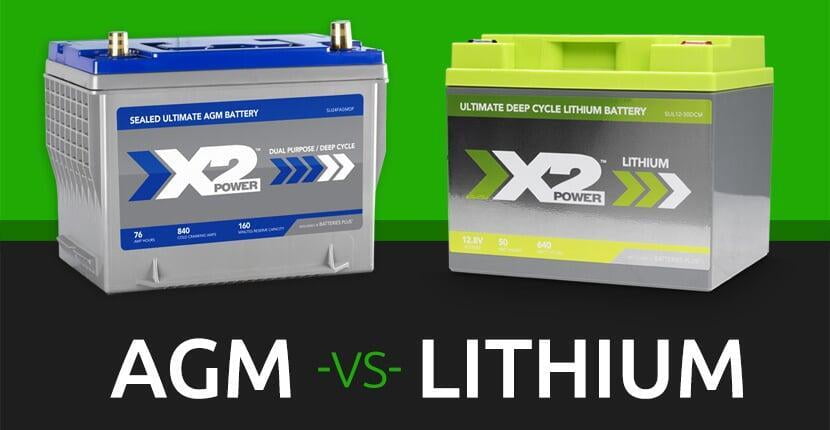
When it comes to batteries there are several options. Batteries are the key to consistent and reliable power for your mobile surveillance system. As such choosing the right battery is important. At GoView we use all 3 types of batteries listed below. The type of battery used depends on many factors. If cost was not an issue, we would use LiFePo4 (lithium) batteries in more applications and we anticipate that in the future we will use more lithium batteries on our trailers. Currently the market/competition and other factors are still preferring lead acid battery technology. An additional reason why we currently prefer AGM or Gel batteries on our mobile trailers is because they tend operate better under sub optimal conditions and are less prone to accidental damage or damage due to adverse environmental conditions. Lets look at the different types of batteries and their advantages and disadvantages.
3 Main Types of Battery Technology
AGM BATTERIES: AGM stands for (absorbed-glass-mat) This is a new version of SLA or sealed lead acid battery
GEL BATTERIES: this is a type of sealed lead acid battery
LITHIUM or LiFeP04: Lithium Iron Phosphate
Depth of Discharge (DoD)
When you start discharging a battery beyond a specific limit, it begins to suffer damage. Depth of discharge measures the percentage of the initial charge that can safely be discharged without causing harm.
Lithium Batteries
Modern lithium-ion batteries have a depth of discharge of 98%. So you can discharge almost the entire charge without damaging the unit. This provides optimal conditions for use with most of the stored power available.
AGM and Gel Batteries
Like other lead-acid batteries, the depth of discharge is about 80% when new and 50% when older. This makes them less competitive compared to lithium-ion batteries.
Winner: Lithium-ion batteries have the highest depth of discharge and a longer operating time.
Lifespan
Regardless of type, a gradual decrease in performance occurs over a battery’s lifespan. There is a point in time when the battery will become useless.
Lithium Batteries
LFP technology is known for its superior durability, typically degrading by less than 1% per year and providing about a 10,000 charge cycle life.
AGM Batteries
These degrade quickly, providing a useful lifespan of about 500 charge/discharge cycles.
Gel Batteries
These are better than AGM, providing a useful lifespan of about 2000-3000 charge/discharge cycles.
Winner: A lithium-ion battery has a considerably longer lifespan, typically about six times longer than an AGM battery.
Size and Weight
Size is a key concern for people working with limited space. This is more of a factor on our pole mount systems and is the key reason we use Lithium on our pole mounted solutions. Lithium batteries weigh approximately 50% less than AGM and GEL batteries for the same energy capacity.
Lithium Batteries
Lithium-ion batteries weigh less due to the absence of any liquid acid. Additionally, since they have a higher depth of discharge, a smaller lithium-ion battery can provide the same power as a larger lead acid battery.
AGM and Gel Batteries
AGM batteries contain absorbed liquid acid that creates added weight. Additionally, a low depth of discharge means that you need a high-capacity (big) battery for any given application.
Winner: Lithium batteries are the better choice in terms of weight and size.
Charge Time and Efficiency
Lithium-Ion Batteries
Due to their higher efficiency, smaller lithium batteries can do the same job as larger AGM batteries. They also charge faster.
AGM and Gel Batteries
Although they charge considerably faster than wet lead-acid batteries, AGM batteries still charge much slower when we compare them with lithium-ion batteries.
Winner: Lithium-ion batteries charge faster than AGM batteries and over four times faster than general lead-acid batteries.
Operating Temperature Range
Lithium-Ion Batteries
Lithium batteries have a limited operating temperature range and the ranges must be strictly observed or irreversible damage will occur.
Charge Range: 32 F to 114 F
Discharge Range: -4 F to 130 F
AGM and Gel Batteries
While all batteries benefit from optimal operating temperatures, SLA batteries are a bit more resistant to damage at extreme temperatures. When temps dip below -4 F and above 110 F you will get a reduction in capacity by anywhere from 20-30%
Winner: AGM and Gel Batteries are a better choice when it comes to extreme operating environments. Especially for application that require placing the batteries in a non climate controlled enclosure during summer and winter months, we find that this is currently the biggest factor in using AGM and GEL batteries. There are advances being made with lithium and sodium based batteries and we are hopeful that in the near future we will have battery storage options that overcome this limiting factor. Another alternative is to insulate your battery storage compartment and use a heating element with a thermostat to keep batteries in a more optimal range. This will greatly extend the life of any battery. Temperature effects all other performance parameters more than any other factor.
Initial Cost
Cost is one of the most important factors when deciding between two battery types. There are two cost factors to consider – the initial cost and the cost per kWh. Here we will discuss the initial cost of each option.
Lithium-ion batteries require a higher upfront cost. Although lithium-ion batteries outperform AGM batteries when considering all other parameters, the initial cost is much higher.
Winner: AGM batteries win when you compare the initial cost. Over a longer time frame LiFePo4 may have a lower cost.
